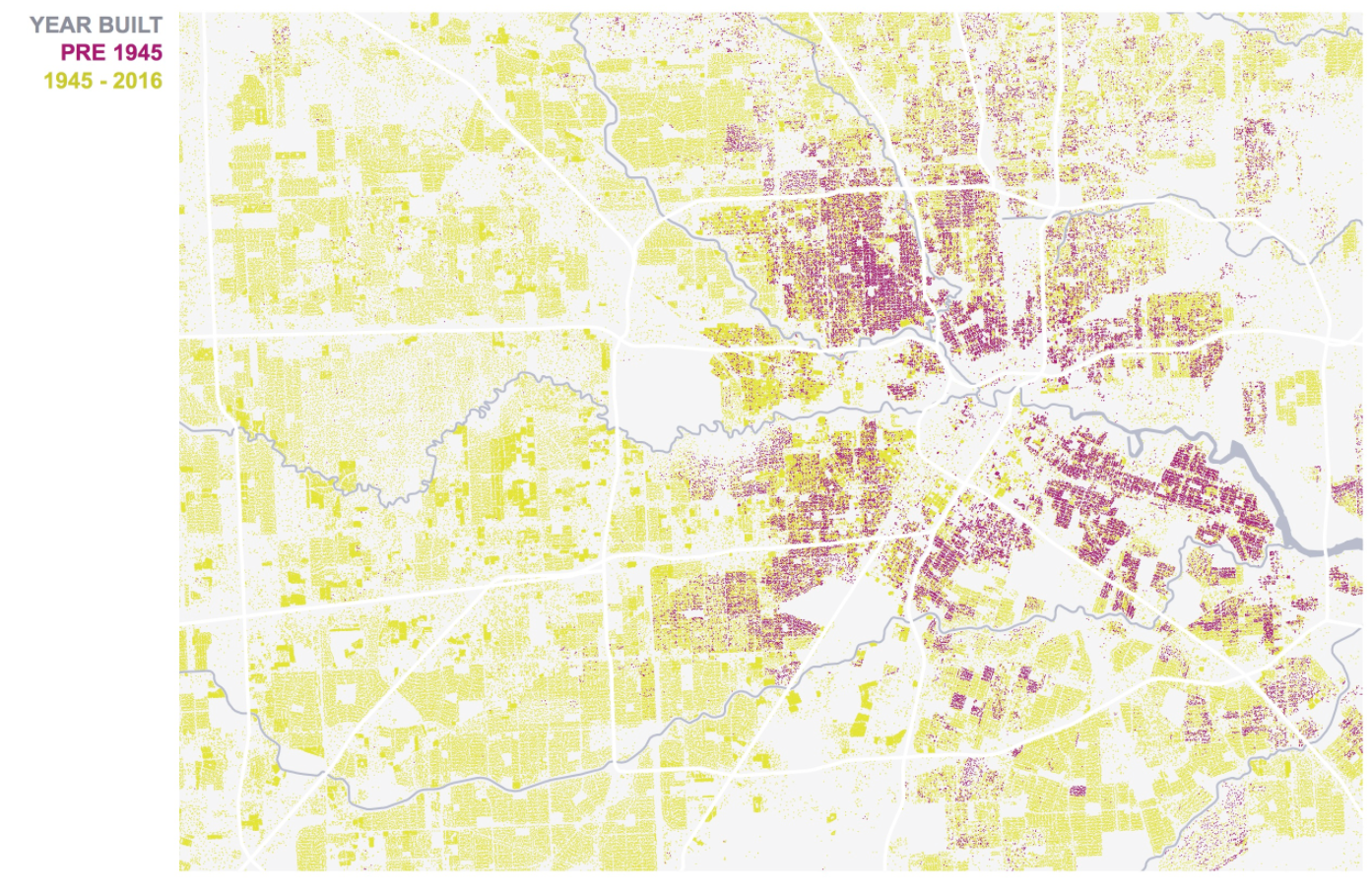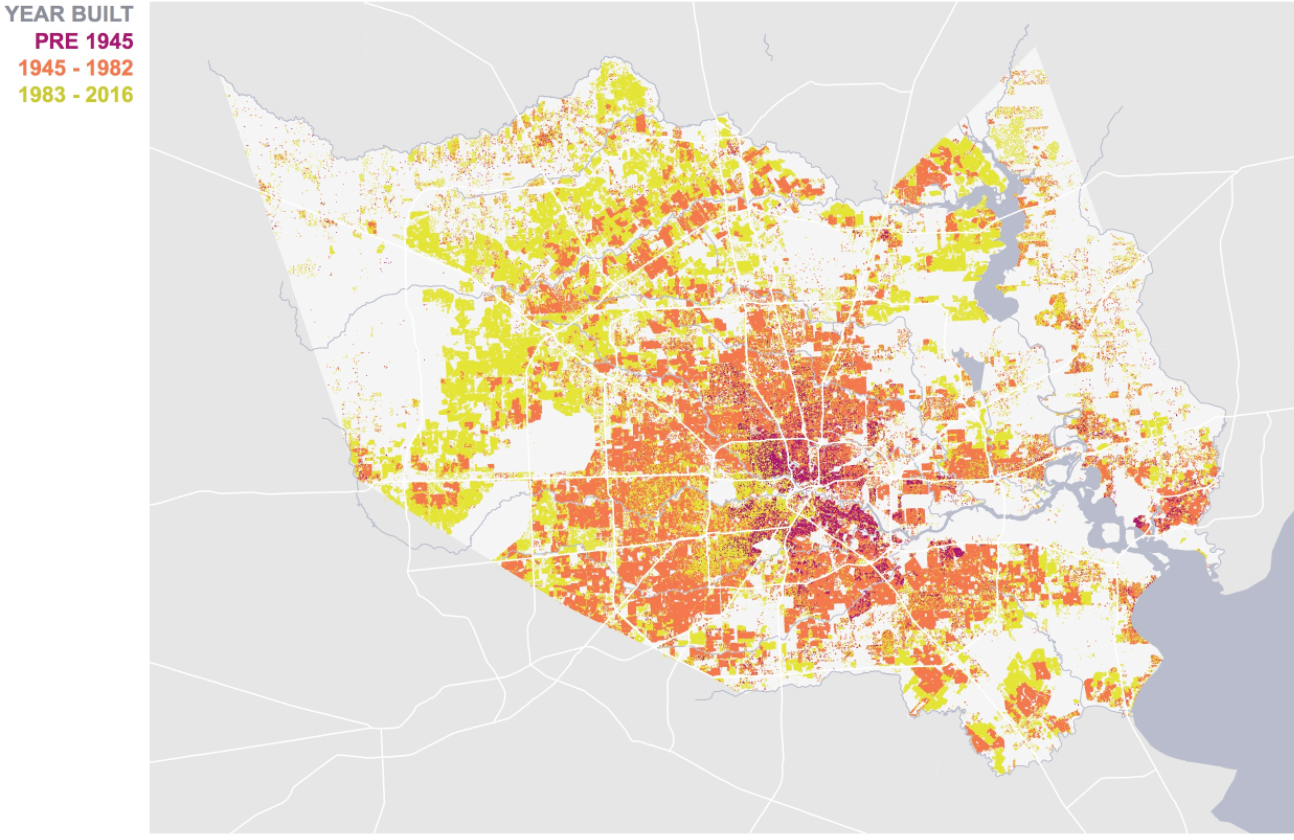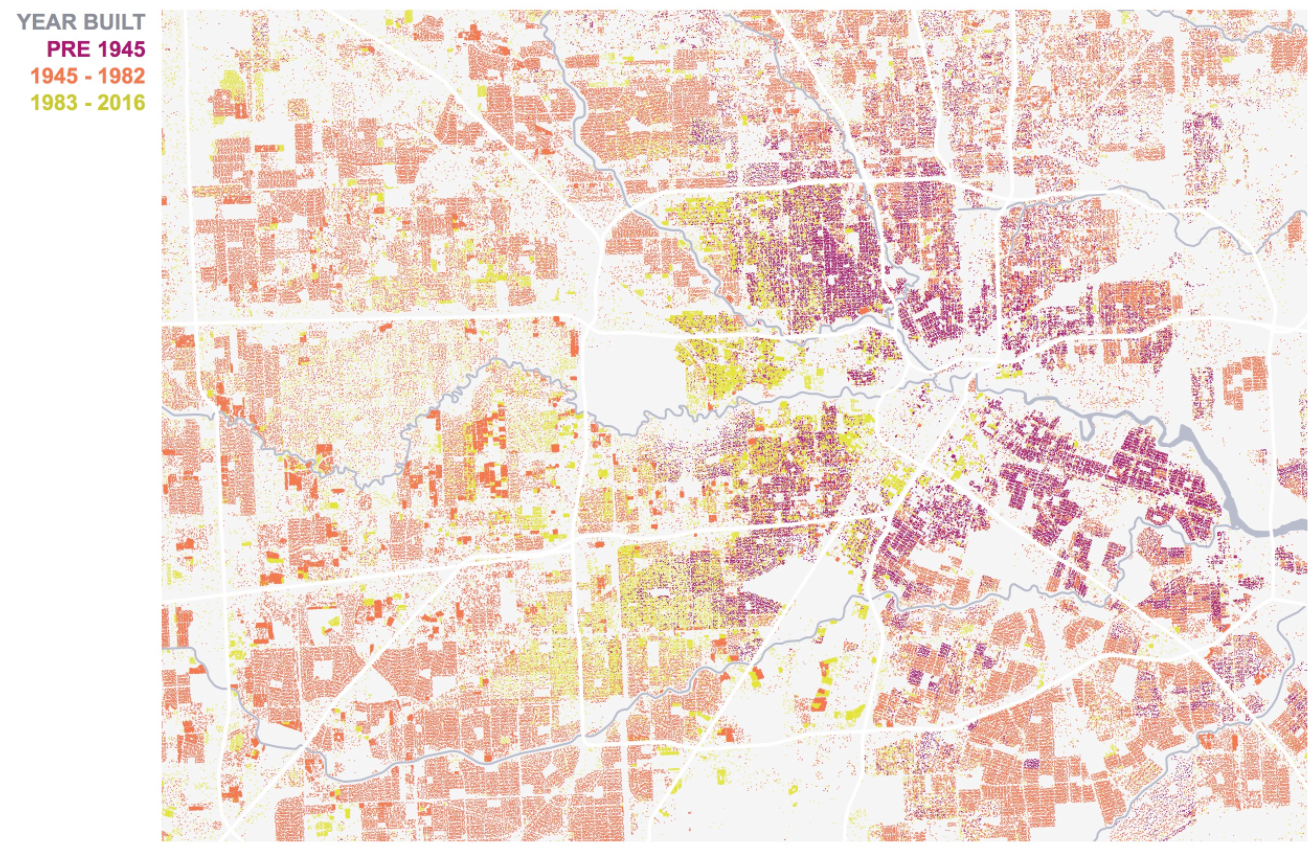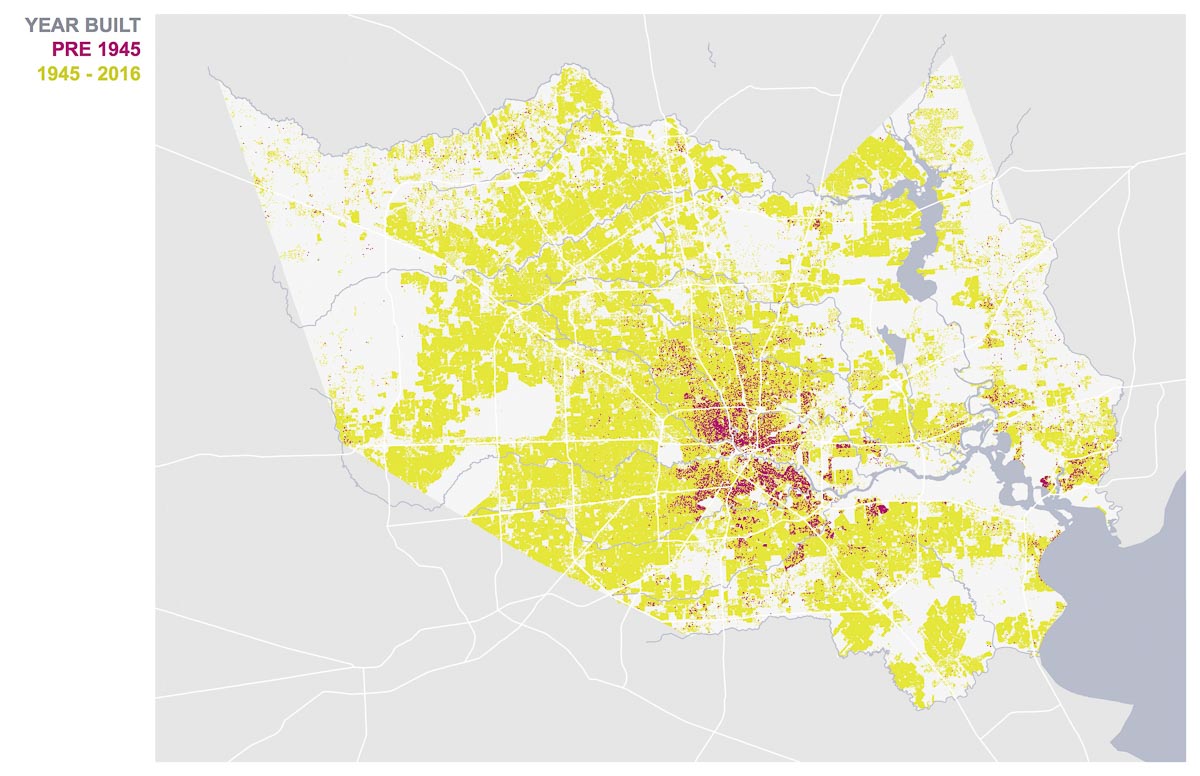This article is part of a special series about preservation in Houston, edited by Helen Bechtel. It was originally published by Cite as a collaboration of the Rice Design Alliance and Rice University's Kinder Institute for Urban Research.
Another year has passed but Houston is forever young. Or so it seems. Whether we love or hate living in Houston, our arguments about the region tend to come back to the same assertion: Houston is young. Our youth explains so much, after all, like how few pedestrian-friendly streets there are and how unfinished the city feels.
Except that Houston is, in fact, old. At least for a city in the United States. It was founded in 1836. Chicago was incorporated in 1837, San Francisco in 1849, Seattle in 1851, and Denver in 1858. Those younger cities seem older, though. Why do their streets have long stretches of storefronts and walk-up apartments? Why do they have old markets filled with tourists buying tchotchkes? Why do their neighborhoods seem layered with histories? Why not us? Why does Houston seem young? One reason has to do with when and how the city grew.
“By the turn of the twentieth century, Houston was a provincial city even by Texas standards,” says Stephen Fox, a fellow of the Anchorage Foundation who teaches at Rice University and the University of Houston, and is author of the Houston Architectural Guide. Other cities, though incorporated after Houston, grew faster in their early years. Chicago reached the “big city” threshold very quickly with a population of more than 2 million by 1910. That same year, San Francisco’s population reached 416,912. By contrast, Houston had a modest 78,800 people. As a result, the footprint of early twentieth-century Houston is small in comparison to its big-city peers today.

Pre- and post-1945 buildings for Loop 610 area of Houston. Courtesy Kinder Institute, source HCAD.
Kelsey Walker, a researcher at Rice University’s Kinder Institute for Urban Research, produced maps that show when Houston developed using records from the Harris County Appraisal District. (The data are from 2015 and include buildings that were expected to be completed in 2016.) Viewed together, the maps present a compelling story about Houston’s recent coming-of-age. Walker’s images show that the overwhelming majority of development has occurred within the last 35 years, and grand swaths of the “old” city have been replaced with newer buildings.
Walker first created a map showing buildings constructed before 1945 in purple and from 1945 to today in yellow. According to Walker’s analysis, only 6.1 percent of all current buildings inside Harris County were built before 1945. Even within incorporated Houston, only 11.2 percent of current buildings were built before 1945.
The year 1945, coinciding with the end of World War II, was a pivot point for cities in the United States and elsewhere. As Rice Architecture Professor Albert Pope explains in an interview for OffCite.org, “In the 1950s, just about the entire world abandoned continuous block-and-street urbanism and switched over to spine-based urbanism.”
Most of pre-1945 Houston is inside Loop 610. The post-1945 world of spine-based urbanism — cul-de-sacs not grids, frontage roads not boulevards — constitutes a far bigger portion of Houston, mostly outside the Loop.
And many of the pre-1945 buildings, the map shows, were demolished. Houston’s oldest areas, like Downtown, have lost a large part of their historic fabric. Though much of Downtown remains vacant or used for surface parking, the blankness is exaggerated in these maps. The single pixels for block-filling buildings tend to underrepresent what does remain. Each little house, however, get its own pixel, so residential neighborhoods come across as dense patches.

Pre-1945, 1945-82, and 83-present buildings in Harris County. Courtesy Kinder Institute, source HCAD.
So is this why Houston seems so young? Young buildings certainly create a youthful urban context. But there’s more to it, as a closer look reveals that the pattern of post-1945 building tells as much of a story about redevelopment as it does development. Walker created maps breaking up the later time period in two — pre-1945 in purple, 1945-to-1982 in orange, and 1983-to-today in yellow. The year 1982 marks the end of a major economic cycle for Houston when the price of oil plummeted and real estate investment paused for several years. These maps represent the incredible pace of Houston’s expansion outward into farmland and prairie.
The new buildings from 1983 onwards are not only at the outer edges. Rather, they show a trend for redevelopment back within the Loop. “What stands out to me is the amount of re-building in older areas going on in the 1983 to 2016 period,” says Fox.

Pre-1945, 1945-82, and 83-present buildings in Loop 610 area. Courtesy Kinder Institute, Pre
Pre-1945, 1945-82, and 83-present buildings in Loop 610 area. Courtesy Kinder Institute, source HCAD.
You can see bright patches of yellow new construction close to Downtown in historic African-American neighborhoods like Third Ward, especially the area now called Midtown and just east of the 288-69 interchange.

Third Ward detail.
You can appreciate how working-class and immigrant Houstonians have preserved buildings in a large area between I-45 and the Ship Channel.

East End map detail.
When real estate dynamics and city policies shift, however, you can see dramatic changes in old neighborhoods like the ethnically and racially-mixed First Ward and in what were mostly working-class, often Anglo enclaves like Cottage Grove, Greater Heights, Rice Military, and parts of Montrose. The near complete loss of old buildings in Freedmen’s Town appears as a bright patch of yellow.

Detail showing change in Heights, Washington Avenue corridor, First and Fourth Wards, Montrose and Freedmen's Town.
There are striking examples where the “entire housing stock has been virtually displaced,” as Fox notes, and parts of Houston have “become a new city despite the actual age.” You can drill down on where demolitions are taking place at a neighborhood level using Kinder Institute’s Houston in Flux interactive map.

Detail of West University, Braes Heights, Bellaire and Southside Place.
Also striking is how big the orange belly is. According to the HCAD data, our buildings are 6.1 percent pre-1945, 47.7 percent between 1945 and ’82, and 46.3 percent after ’82. Why does Houston seem young? Almost half of it is young. To put it another way: Houston is half-Millennial, half-Boomer, but we have a little, old heart that needs preserving.
If we can only give one age for Houston, though, what would that be? Walker calculated the average (median) age of our buildings. The median year is 1970 for Houston and 1981 for Harris County. By these measures, Houston is about 47 (Baby Boomer) and Harris County is 36 (Millennial).
Still, Fox points out, the age of buildings is not the only factor to shape perceptions of the city. Dallas not only grew faster than Houston in its early years and has more “density and texture,” he says, but “because the streets are narrower and two grids come together at an angle [around Ross Avenue], you have a sense of closure.” The old grids of Houston have wide streets with seemingly endless vistas. In addition, the spine-based urbanism outside the Loop that Pope calls our attention to have even less sense of closure and spatial intimacy.
“All of these perceptions color your interpretation and deduction about the character and age of a city and probably make a greater impact than the chronological age,” says Fox. Houston outside the Loop is aging without seeming “old.”
Yet another factor beyond the age of the buildings is who occupies them. Our population is young. The median ages in Houston and Harris County are 34 and 32. Houston’s median age is the lowest of the nation’s major metro areas.
These maps and figures raise a host of questions about Houston’s growth that contributors to OffCite and Kinder Institute’s Urban Edge have explored in articles listed below.
What do you see in these maps?
Further Reading
Rogers, Susan. “The Beautiful Projects: Contradiction and Complexity in Houston’s Multifamily Housing.” OffCite.org. July 11, 2014.
West, Allyn. “Uncommon Attention: A Photographic Exhibition of Houston’s Mid-Century Background Buildings.” OffCite.org. February 11, 2016.
Binkovitz, Leah. “Third Ward Looks to Shift the Gentrification Conversation.” Urban Edge. May 25, 2016.
Mankad, Raj. “Houston’s First Mixed-Use, Mixed-Income, Transit-Oriented Development.” OffCite.org. August 24, 2016.
Rogers, Susan. “Hazardous: The Redlining of Houston Neighborhoods.” OffCite.org. October 4, 2016.
Joseph, Cheryl and Raj Mankad. “Managing Change Starts with Memory: Preserving Communities of Color Workshop.” OffCite.org. November 16, 2016.

